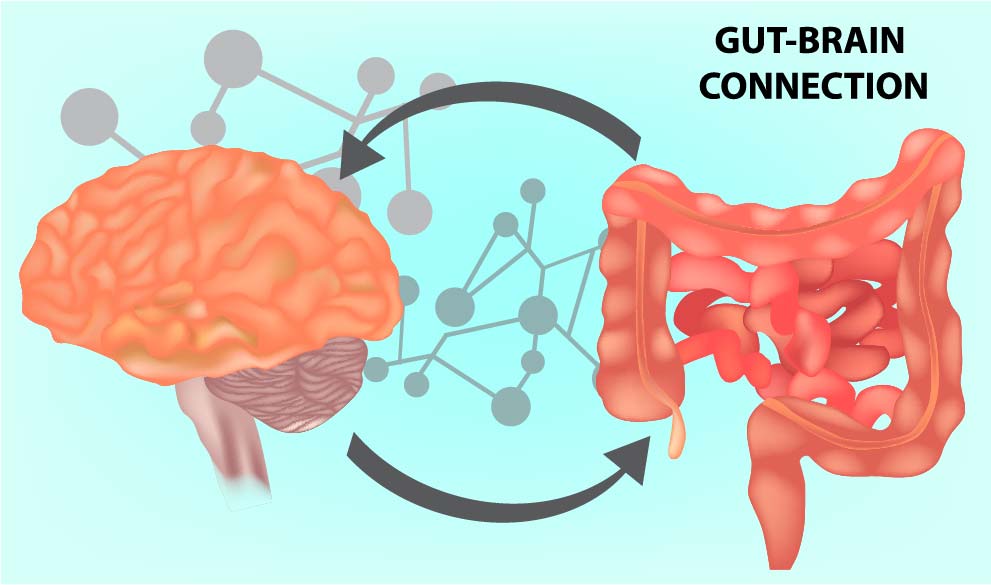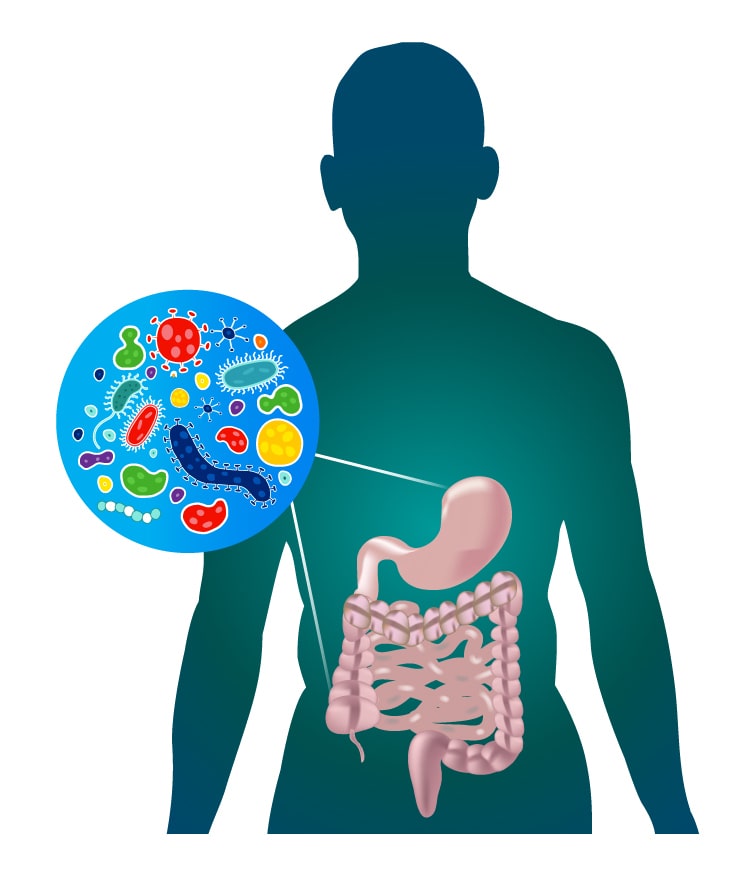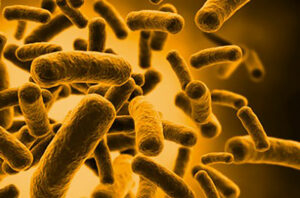


The human nervous system is linked throughout the entire body and is composed of the peripheral and the central nervous system. The central nervous system makes up the brain and the spinal cord. Whereas the peripheral nervous system communicates to all the organs in the body as well as the different limbs. The peripheral nervous system is responsible for sending signals throughout the body and receiving responses from different stimuli. Some of the stimuli received by peripheral nervous system include pain signals or other sensations to help humans interact with the world around them. The nervous system is also highly interlinked with the endocrine system which is responsible for sending hormones throughout the body. These hormones signal the body to coordinate different functions such as development and growth. For example, various sex hormones as well as antioxidants and cytokines and sent throughout the body at a very fast pace to properly respond to an event 12 The nervous system may receive or send messages quickly, consequently, manifested by running faster or trying to lift a heavy object. The enteric nervous system is the nervous system which makes up the intestinal track, and is, a subset of the main nervous system. The enteric nervous system is very complex as it resembles part of the central nervous system, specifically, it is structured and has numerous and diverse cells 13 The enteric nervous system may also collect different chemicals which bacteria produce and may send these chemicals to the brain.

Bacteria that are present within the intestinal microbiota may elevate anxiety levels in addition to depression and other moods 24 Some microorganisms in the human intestine are known to produce cytokines that may cause inflammation. Scientists have also been examining how these bacteria cause inflammation within the human GI tract which leads to increased levels of stress within the body, that may add stress to the brain itself 16 Schizophrenia is a disease that presents symptoms of disturbing thoughts as well as a slowed thinking process. This disease may also interfere with how well people are able to remember things. Scientists have also discovered that the bacteria, known as Proteobacteria, may influence cytokine production and again alter the intestine balance thus, leading to levels of increased inflammation. In addition to schizophrenia, increased dominance of firmicutes over Proteobacteria within the salivary glands may lead to a disorder known as Sjogren’s syndrome. This disease causes disfunction within the salivary in the oral and ocular glands and may lead to dryness in these cavities 26 Bipolar disorder is another disorder which affects a person’s mental health. The person with bipolar disorder may begin to have altered moods which can lead to episodes of violence. It is very similar to depression and schizophrenia and overtime may lead to mania, where an individual experiences highs and lows for weeks to months on end 16 In the case of bipolar disorder, the bacterium known as Flavonifractor was shown to be in high abundance in the intestinal wall making it more permeable 16 This shows how a certain bacterium can cause inflammatory properties within the GI tract. The bacteria has the ability to cleave a certain flavonoid known as quercetin, which has anti-inflammatory properties 29 Bifidobacterium spp. Also may play a role inflammatory bowel disease, which causes severe inflammation of the intestines 16 Meanwhile, other anti-inflammatory factors that prevent the GI tract from swelling were shown to be less abundant 16 This illustrates how important gut microbiota are to the person’s health. Obsessive Compulsive Disorder, (OCD), may cause a person to have very ritualistic behavior/fixations. Again, certain bacteria were shown to be present profusely, and were therefore, leading to more inflammation causing the alteration of a pathway 16 People may suffer from these disorders for the rest of their lives.
In addition to bacteria playing a role in affecting the body’s mood, certain trace amines may also affect the body as well. These amines are normally found in food and are degraded by microorganisms. One of the more studied amines, TAAR1, has been shown to have a role in regulating, dopaminergic, serotonergic, and glutamatergic transmission 16 Therefore, by utilizing this compound for therapy, it may be able to treat ailments such as depression and schizophrenia by altering dopamine and serotonin uptake and thus helping the body to be in an overall better mood. Within the brain, and the body there may be a deficiency known as AADC or Aromatic l-amino acid decarboxylase deficiency which is regulated by glutamate dopamine and serotonin 16 Furthermore, when there is not much uptake of these neurotransmitters, there is not a lot of tyrosine present, which may alter brain activity and function 16 Another possible solution to combatting these ailments of depression and schizophrenia could be by designing a drug which could alter tyrosine levels within the brain in order to increase neurotransmitter uptake. In addition to this, there has also been studies on CCK, or Cholecystokinin, which is a brain neuropeptide that is found in foods with high amounts of protein. This peptide can be found within the hypothalamus and production of this peptide may stimulate bile within the gall bladder and bind gastrin, to cause gastric acid to be produced which may also increase anxiety 16
All in all, bacteria play many different roles in the environment. They can help decompose organisms and regulate certain biological functions. Bacteria may also help in the creation of certain medications and vaccines while also being considered for use in cloning and gene therapy. Another field that is relatively new, but shows great promise, is how bacteria may help heal tissue and increase food production. In addition, another application of bacteria is to use them to clean up oil spills, help maintain nitrogen, and breakdown matter within the soil. Surprisingly, bacteria can perform photosynthesis while living in extreme climates, even today, such as deep thermal vents in the depths of the ocean or cold climates. We know bacteria help eukaryotic cells with certain processes such as photosynthesis or cellular respiration, which are very important for energy use and production. Most importantly, when bacteria are present within the human body, particularly the intestines, rather than causing a respiratory illness such as a cold or flu, they can alter mental behavior and completely change one’s lifestyle. Unfortunately, in the extreme case where this might lead to schizophrenia or autism, it can greatly impact a person’s life. While there is still much research to be done in this field, examination of exactly how bacteria can influence the pathways of the brain, the research that has already been done shows that there is a clear connection with bacteria and the chemicals they produce. Moreover, these chemicals can have a drastic effect on how the brain functions. With continued research in this area, scientists will be able to help combat mental illness by prescribing drugs that stop bacteria from producing certain chemicals or by blocking their transition past the GI barrier.
- Arnaout, Author: Bassel. “The Gut Microbiome and Its Effects on Human Health.” Norgen Biotek Corp., 4 June 2021, https://norgenbiotek.com/blog/gut-microbiome-and-its-effects-human-health. ↵
- Rosenberg, N., Reva, M., Binda, F., Restivo, L., Depierre, P., Puyal, J., Briquet, M., Bernardinelli, Y., Rocher, A.-B., Markram, H., & Chatton, J.-Y. (2023). Overexpression of UCP4 in astrocytic mitochondria prevents multilevel dysfunctions in a mouse model of Alzheimer’s disease. Glia, 71(4), 957–973. https://doi-org.blume.stmarytx.edu/10.1002/glia.24317 ↵
- Kim, D. B., Na, C., Hwang, I., & Lee, D. W. (2023). Understanding protein translocation across chloroplast membranes: Translocons and motor proteins. Journal of Integrative Plant Biology, 65(2), 408–416. https://doi-org.blume.stmarytx.edu/10.1111/jipb.13385 ↵
- Kim, D. B., Na, C., Hwang, I., & Lee, D. W. (2023). Understanding protein translocation across chloroplast membranes: Translocons and motor proteins. Journal of Integrative Plant Biology, 65(2), 408–416. https://doi-org.blume.stmarytx.edu/10.1111/jipb.13385 ↵
- Lock, N. E., Sawyer, A. A., Wise, L., Bhatia, J., & Stansfield, B. K. (2022). Vitamin K and ECMO for neonatal hypoxic respiratory failure. Perfusion, 37(5), 484–492. https://doi-org.blume.stmarytx.edu/10.1177/02676591211003870 ↵
- Somov, Andre. “What’s Human Gut Microbiome? Importance of Microbiome.” Vegetarian, 10 Apr. 2019, https://www.globalvegetarian.ca/human-gut-microbiome/. ↵
- Dicks, L. M. T., Hurn, D., & Hermanus, D. (2021). Gut Bacteria and Neuropsychiatric Disorders. Microorganisms, 9(12). https://doi-org.blume.stmarytx.edu/10.3390/microorganisms9122583 ↵
- Bodnar, T. S., Raineki, C., Wertelecki, W., Yevtushok, L., Plotka, L., Zymak-Zakutnya, N., Honerkamp-Smith, G., Wells, A., Rolland, M., Woodward, T. S., Coles, C. D., Kable, J. A., Chambers, C. D., & Weinberg, J. (2018) Altered maternal immune networks are associated with adverse child neurodevelopment: Impact of alcohol consumption during pregnancy. Brain, Behavior, and Immunity, 73, 205–215. https://doi-org.blume.stmarytx.edu/10.1016/j.bbi.2018.05.004 ↵
- Bäckhed, F., Ley, R. E., Sonnenburg, J. L., Peterson, D. A., & Gordon, J. I. (2005). Host-Bacterial Mutualism in the Human Intestine. Science, 307(5717), 1915–1920. http://www.jstor.org/stable/3841877 ↵
- NandaKafle, G., & Reese, R. N. (2011). In Vitro Antimicrobial Activity of Native South Dakota Plant Extracts on Escherichia Coli. Proceedings of the South Dakota Academy of Science, 90, 180 ↵
- Micenkova, L., Bosak, J., Smatana, S., Novotny, A., Budinska, E., & Smajs, D. (2020). Administration of the Probiotic Escherichia coli Strain A0 34/86 Resulted in a Stable Colonization of the Human Intestine During the First Year of Life. Probiotics And Antimicrobial Proteins, 12(2), 343. https://doi-org.blume.stmarytx.edu/10.1007/s12602-019-09548-3 ↵
- Abuaish, S., Al-Otaibi, N. M., Aabed, K., Abujamel, T. S., Alzahrani, S. A., Alotaibi, S. M., Bhat, R. S., Arzoo, S., & El-Ansary, A. (2021). The role of sex-differentiated variations in stress hormones, antioxidants, and neuroimmune responses in relation to social interaction impairment in a rodent model of autism. Metabolic Brain Disease, 36(6), 1369–1379. https://doi-org.blume.stmarytx.edu/10.1007/s11011-021-00732-5 ↵
- Baruhee, D., Ganapathy, A., Singh, S., Sarwar, S., Banerjee, A., Bhukya, S., Quadri, J. A., & Shariff, A. (2023). Morphology of human fetal enteric neurons: A comparative study of different segments of the colon. Morphologie: Bulletin de l’Association Des Anatomistes, 107(356), 38–46. https://doi-org.blume.stmarytx.edu/10.1016/j.morpho.2022.03.001 ↵
- Gabarrou, Jean-François. “Microbiota and Brain: How Does Their Dialogue Affect the Farm Animal?” Planète Élevage, 20 Aug. 2021, https://livestock-world.com/microbiota-and-brain-how-does-their-dialogue-affect-the-farm-animal/. ↵
- Wang, L., Zhang, J., Guo, C., He, J., Zhang, S., Wang, Y., Zhao, Y., Li, L., Wang, J., Hou, L., Li, S., Wang, Y., Hao, L., Zhao, Y., Wu, M., Fang, J., & Rong, P. (2022). The efficacy and safety of transcutaneous auricular vagus nerve stimulation in patients with mild cognitive impairment: A double blinded randomized clinical trial. Brain Stimulation, 15(6), 1405–1414. https://doi-org.blume.stmarytx.edu/10.1016/j.brs.2022.09.003 ↵
- Dicks, L. M. T., Hurn, D., & Hermanus, D. (2021). Gut Bacteria and Neuropsychiatric Disorders. Microorganisms, 9(12). https://doi-org.blume.stmarytx.edu/10.3390/microorganisms9122583 ↵
- Dicks, L. M. T., Hurn, D., & Hermanus, D. (2021). Gut Bacteria and Neuropsychiatric Disorders. Microorganisms, 9(12). https://doi-org.blume.stmarytx.edu/10.3390/microorganisms9122583 ↵
- Adebayo, O. G., Asiwe, J. N., Ben, A. B., Aduema, W., Onyeleonu, I., Akpotu, A. E., Wopara, I., Kolawole, T. A., Umoren, E. B., Igbokwe, V., Buduburisi, B. R., Onwuka, F. C., & Brown, P. I. (2022). Ginkgo biloba protects striatal neurodegeneration and gut phagoinflammatory damage in rotenone‐induced mice model of Parkinson’s disease: Role of executioner caspase‐3/Nrf2/ARE signaling. Journal of Food Biochemistry, 46(9), 1–18. https://doi-org.blume.stmarytx.edu/10.1111/jfbc.14253 ↵
- Xiaoyi Xu (许潇依), Xin He (何鑫), Zeyan Zhang (张泽彦), Yanyi Chen (陈彦伊), Junyu Li (黎俊宇), Shanshan Ma (马珊珊), Qiaoying Huang (黄巧莹), & Mingtao Li (黎明涛). (2022). CREB Inactivation by HDAC1/PP1c Contributes to Dopaminergic Neurodegeneration in Parkinson’s Disease. Journal of Neuroscience, 42(22), 4594–4604. https://doi-org.blume.stmarytx.edu/10.1523/JNEUROSCI.1419-21.2022 ↵
- Dicks, L. M. T., Hurn, D., & Hermanus, D. (2021). Gut Bacteria and Neuropsychiatric Disorders. Microorganisms, 9(12). https://doi-org.blume.stmarytx.edu/10.3390/microorganisms9122583 ↵
- Runge, K., Fiebich, B. L., Kuzior, H., Rausch, J., Maier, S. J., Dersch, R., Nickel, K., Domschke, K., van Elst, L. T., & Endres, D. (2023). Altered cytokine levels in the cerebrospinal fluid of adult patients with autism spectrum disorder. Journal of Psychiatric Research, 158, 134–142. https://doi-org.blume.stmarytx.edu/10.1016/j.jpsychires.2022.12.032 ↵
- Dicks, L. M. T., Hurn, D., & Hermanus, D. (2021). Gut Bacteria and Neuropsychiatric Disorders. Microorganisms, 9(12). https://doi-org.blume.stmarytx.edu/10.3390/microorganisms9122583 ↵
- Dicks, L. M. T., Hurn, D., & Hermanus, D. (2021). Gut Bacteria and Neuropsychiatric Disorders. Microorganisms, 9(12). https://doi-org.blume.stmarytx.edu/10.3390/microorganisms9122583 ↵
- Bagga, D., Reichert, J. L., Koschutnig, K., Aigner, C. S., Holzer, P., Koskinen, K., Moissl-Eichinger, C., & Schöpf, V. (2018). Probiotics drive gut microbiome triggering emotional brain signatures. Gut Microbes, 9(6), 486–496. https://doi-org.blume.stmarytx.edu/10.1080/19490976.2018.1460015 ↵
- Dicks, L. M. T., Hurn, D., & Hermanus, D. (2021). Gut Bacteria and Neuropsychiatric Disorders. Microorganisms, 9(12). https://doi-org.blume.stmarytx.edu/10.3390/microorganisms9122583 ↵
- Brito-Zerón, P., Retamozo, S., & Ramos-Casals, M. (2023). Sjögren syndrome Medicina Clinica, 160(4), 163–171. https://doi-org.blume.stmarytx.edu/10.1016/j.medcli.2022.10.007 ↵
- Dicks, L. M. T., Hurn, D., & Hermanus, D. (2021). Gut Bacteria and Neuropsychiatric Disorders. Microorganisms, 9(12). https://doi-org.blume.stmarytx.edu/10.3390/microorganisms9122583 ↵
- Dicks, L. M. T., Hurn, D., & Hermanus, D. (2021). Gut Bacteria and Neuropsychiatric Disorders. Microorganisms, 9(12). https://doi-org.blume.stmarytx.edu/10.3390/microorganisms9122583 ↵
- 5. Dicks, L. M. T., Hurn, D., & Hermanus, D. (2021). Gut Bacteria and Neuropsychiatric Disorders. Microorganisms, 9(12). https://doi-org.blume.stmarytx.edu/10.3390/microorganisms9122583 ↵
- Dicks, L. M. T., Hurn, D., & Hermanus, D. (2021). Gut Bacteria and Neuropsychiatric Disorders. Microorganisms, 9(12). https://doi-org.blume.stmarytx.edu/10.3390/microorganisms9122583 ↵
- Dicks, L. M. T., Hurn, D., & Hermanus, D. (2021). Gut Bacteria and Neuropsychiatric Disorders. Microorganisms, 9(12). https://doi-org.blume.stmarytx.edu/10.3390/microorganisms9122583 ↵
- Dicks, L. M. T., Hurn, D., & Hermanus, D. (2021). Gut Bacteria and Neuropsychiatric Disorders. Microorganisms, 9(12). https://doi-org.blume.stmarytx.edu/10.3390/microorganisms9122583 ↵
- Dicks, L. M. T., Hurn, D., & Hermanus, D. (2021). Gut Bacteria and Neuropsychiatric Disorders. Microorganisms, 9(12). https://doi-org.blume.stmarytx.edu/10.3390/microorganisms9122583 ↵
- Dicks, L. M. T., Hurn, D., & Hermanus, D. (2021). Gut Bacteria and Neuropsychiatric Disorders. Microorganisms, 9(12). https://doi-org.blume.stmarytx.edu/10.3390/microorganisms9122583 ↵
- Dicks, L. M. T., Hurn, D., & Hermanus, D. (2021). Gut Bacteria and Neuropsychiatric Disorders. Microorganisms, 9(12). https://doi-org.blume.stmarytx.edu/10.3390/microorganisms9122583 ↵
- Dicks, L. M. T., Hurn, D., & Hermanus, D. (2021). Gut Bacteria and Neuropsychiatric Disorders. Microorganisms, 9(12). https://doi-org.blume.stmarytx.edu/10.3390/microorganisms9122583 ↵
Tags from the story
microbiome
neurophysiology
Nomination-Biology
Recent Comments
Jonathan Flores
I really love your article! There’s a common misconception that bacteria are always bad, but you expertly proved that wrong. We cannot live without bacteria, and you proved exactly why that is. Of course, there are bacteria that can be very harmful but bacteria in general is a healthy part of any life. Overall, this was a very well done article, and if I were to add anything I would just say touching on super antibiotic resistant bacteria would have been a nice touch.
25/04/2023
2:47 pm
Matthew Holland
It is one of the best of its kind in it the respective section hands down. I look forward to reading more from them in the future and hope they can write about different topics that would be equally interesting. It is seriously incredible how much bacteria can do and how it is doing more than just breaking down food in our bodies.
26/04/2023
2:47 pm
Anayetzin Chavez Ochoa
I’ve heard of taking bacteria from the intestines of healthy people to transfer into sicker patients in order for their gut to be restored, and I know that if intestinal bacteria get anywhere else inside the body, it can cause catastrophic consequences. Just as you said! We are also constantly covered in Streptococcus bacteria, among others, and we (almost) never get sick. I never knew that bacteria linked with the intestines! Thank you for writing this!
27/04/2023
2:47 pm
Hunter Stiles
Hello! Congratulations on your nomination and publication! Being a Biology major, I loved reading your paper. Since I read a bunch of biology-related articles it is easy to get jumbled, reading this one truly helped me understand the significance of microorganisms in a very beneficial way. I enjoyed the way you described how certain germs are beneficial while others pose serious hazards like autism or schizophrenia. Since it is widely believed that bacteria only do harm and cannot produce any benefits, reading this essay truly helped me distinguish between good and harmful bacteria. Amazing job all around! Very well done.
27/04/2023
2:47 pm
Osondra Fournier-Colon
I remember learning how bacteria are everywhere, including inside you, which freaks me out. However, this article does a fantastic job showing how different bacteria have a symbiotic relationship with you. Furthermore, it showcases how beneficial the right kind of bacteria can be; not all bacteria are harmful. I love how you show the process of these bacteria and their formation over time. Lovely article!
28/04/2023
2:47 pm
Illeana Molina
Hello, Anthony! I would like to second Natalia’s comment I love your article, as it is unique and focused. I am also a political science major and do not find myself interested in the in-depth analysis of science. However, after covid, I am now interested and more aware of its importance. I liked how you expressed that some bacteria are needed are being “helpful”. I loved how in-depth you were but at the same time, the information was easy to interpret and understand. Great Job!!
08/05/2023
2:47 pm
Natalia Bustamante
Hello, Anthony! I really enjoyed reading your article, especially since I am a political science major. I never really get to read any type of biology articles, so reading this article really made me aware of the importance of bacteria. I liked how you expressed that some bacteria are helpful, while other bacteria can lead to major risks such as autism or schizophrenia. It is highly associated that bacteria are only bad and do not lead to any good, so reading this article really made me differentiate between good and bad bacteria. Overall, great article Anthony!
24/04/2023
2:47 pm